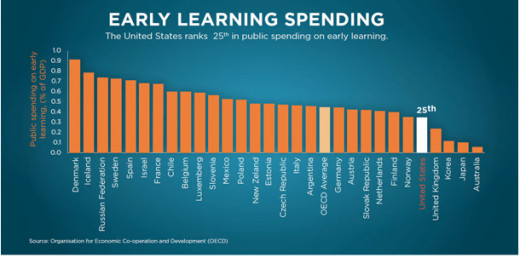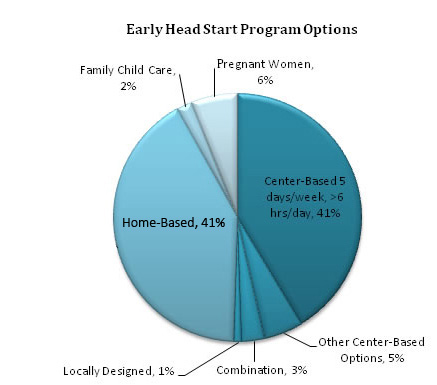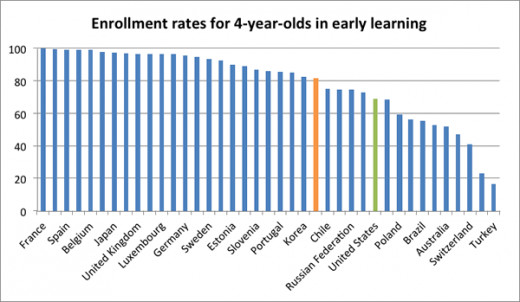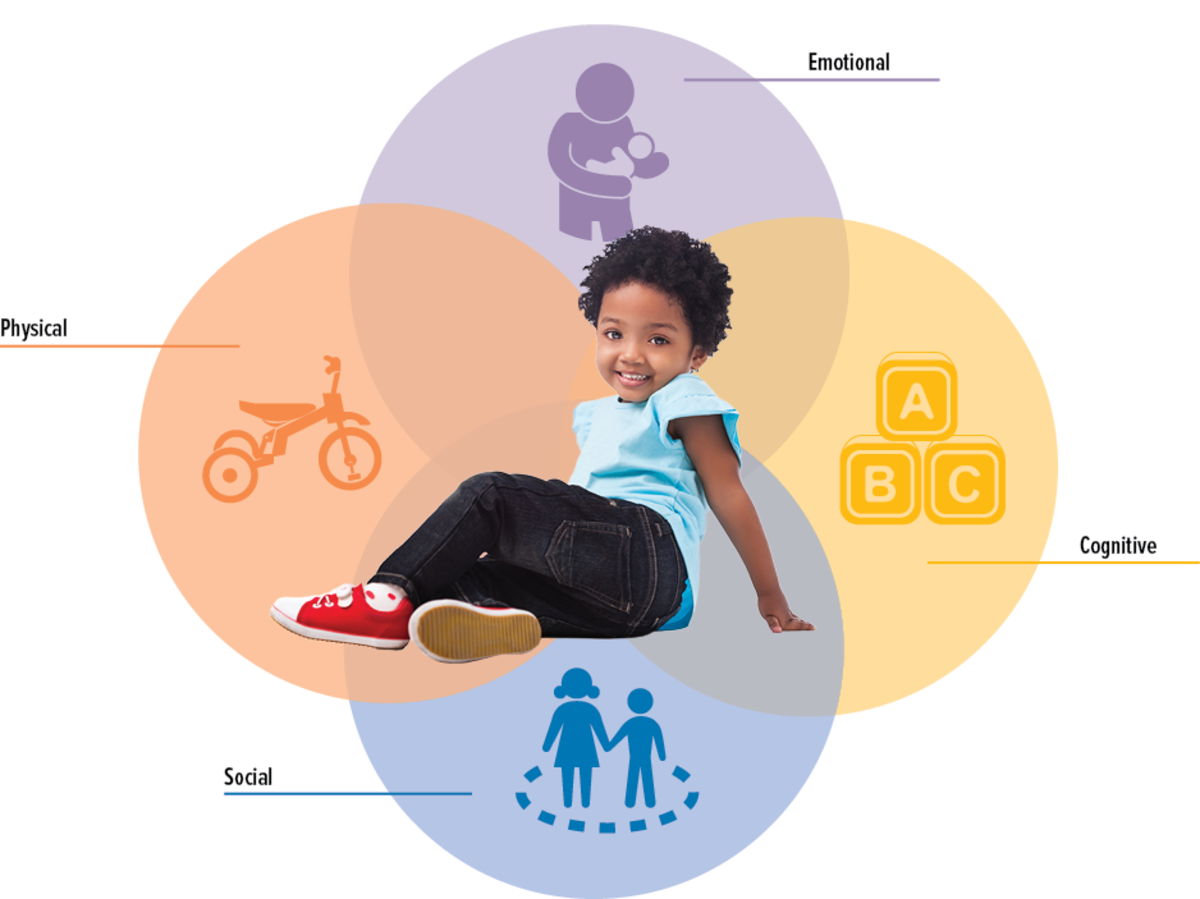Federally Funded

The United States has evolved significantly since the early debates on public schools. The responsibility for education has shifted from local control to state control. Today, focus is coming from the federal government and national organizations to regulate standards. There is a shocking level of debate in regards to early childhood education. There has been question how much structured learning is needed or even beneficial for very young children. A wide variety of studies have demonstrated, when introduced early on, early education programs, whether in a traditional school setting or at home child care facility, will significantly benefit children by the time they reach traditional school ages. Children are better prepared to learn, and are better behaved. It is important to understand the development of early childhood educational concepts and procedures. Early childhood education is a critical starting to the academic careers of children.
Early childhood education benefits children, but also has a positive influence on families and entire communities. From improved academic scores to economic savings, the advantages of high-quality early childhood education is unquestionable. Children who attended early childhood education programs such as Head Start, for example, were further advanced in skills such as following directions, problem-solving, and participating in activities. Early childhood care and education plays an important role in the lives of all family members. It gives children steady routines and countless learning opportunities, while offering families the security of knowing their child is in a safe and nurturing environment. Many children enter some form of child care early on from the time they are infants to the time they enter elementary school. Through these early years, children go through important development stages, and continual, high-quality care can have valuable and long-lasting results on the overall development of children.

In 1964, the Federal Government created a panel of child development experts to design a program to help lower income communities and young children living in poverty. The findings of that panel report became the strategy for Project Head Start. Head Start was, introduced as an eight-week summer program by the Office of Economic Opportunity in 1965, and was developed in hopes of breaking the cycle of poverty by offering preschool children of low-income families with an extensive program to meet their emotional, social, and health needs. Recruiting children age three to school entry age, Head Start was eagerly accepted by education, child development specialists, community leaders and parents. Head Start has had a powerful impact on communities and early childhood programs as a whole. Head Start has a major impact on children’s emotional programming, self-esteem, achievement motivation, and behavior. By the end of the Head Start year, children received higher scores in all three areas than those enrolled in non Head Start programs, Head Start parents claimed to have seen positive changes in their personal lives, behavior, and attitudes.
Over the years the program has developed into the nation's main federally subsidized child development preschool program. Ninety percent of the children served are three and four years old; two-thirds are four-year-olds. About 13% are children with disabilities (Devaney, Ellwood, & Love, 1997, p. 88). The program's curriculum varies across the nation in order to satisfy each communities diverse needs. The number of days per week and hours per day varies. Local programs add other standards regarding family characteristics developed to help Head Start better assist community needs. However, while achieving some progress, Head Start is not providing enough to improve the language, pre-reading, and pre-mathematics skills that are crucial for school readiness. The level of skill in math and reading with young children entering Head Start are much below national averages. While showing a vast improvement, Children graduating from Head Start continue to be far behind the traditional U.S. Child. A follow-up study of children in Head Start in 1997 revealed that children who participate in Head Start make less improvement than the average kindergartener. In summary, there is more work to do. In spite of the positive qualities of Head Start programs, children in Head Start are achieving only moderate advancement in only some areas of knowledge and skill, and children in Head Start are remaining far behind their peers. Additional improvements need to be made and can be made to put Head Start children on track for kindergarten. Even Start is another federally-funded education program which was developed to implement early childhood education to low-income parents for children birth through age 7, combining adult education and early childhood learning with family literacy programs.
Early Head Start is a federally funded community-based program for low-income families. It is a program that was developed under the Head Start Program. Early Head Start Programs offer three specific options. The three choices are: a home-based program, a facility-based program, and a blend of both the facility-based and home based programs. Early Head Start's main objective is to help improve parental development as well as motivate a healthy home environment. However, federal programs developed to boost individual behavior, like Head Start and Early Head Start, have not delivered similar results.Many Americans posses a false understanding of what the federal government can accomplish when it comes to education. In many ways, education is much more complex than just facts and figures. Giving states money and leaving it up to them to determine just how to satisfy families early care and educational needs will not work. There is sufficient research signaling what works in early education and the federal government has a crucial role in assisting to improve states’ initiatives to supply top-quality opportunities. So while the federal government ought to develop improved connections and solid coordination amongst the programs with which it assists support early childhood, programs need incorporate all families, permitting access to every child to high-quality early educational options.

The Chicago Child-Parent Center (CPC) Program is the second oldest federally funded program after Head Start. The program provides families in high-poverty communities. Its goal is to secure children's academic achievement while increasing parent involvement in their children's education. With 24 locations in Chicago neighborhoods, CPC offers services for children, ages 3 to 9. Many of these children are from low-income African-American and Hispanic families. Similar to Head Start, the CPC program provides a well designed educational program, nutrition and health services, community outreach, and services for parental involvement. The CPC program runs from 24 centers in the Chicago Public School system, supplying preschool (ages 3 and 4) and kindergarten services. Another 13 centers, manages services for the first-through-third grades (Thomas, 2014).
It is known that children’s minds are virtually being developed in the early years, and that steady, responsive interactions with nurturing adults are the building materials. Essentially, the early childhood years lay the framework for later physical and mental health, for economic productiveness and accountable citizenship. The primary focus of the majority of early education programs is to improve “school readiness by supplying educational, health, nutritional, social and other services to enrolled children and families.” (Phillips, D 2008). Research concurs that most of these federally funded programs have successfully improved school readiness, incorporating cognitive test scores at kindergarten entry. Since the start of these programs, studies have shown that participants - especially those in lower income areas- enter kindergarten a with a greater advantage and readiness then of those not participating. That is why early education is not only a effective for the children and families who take part, but to society as a whole. As a better educated and financially secured society, there is a better chance for the future as a state.






